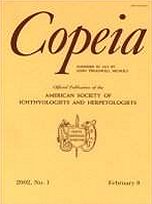In a laboratory experiment, we investigated the effects of low pH environment, a key parameter of acidity, on mortality, growth, and development in two populations of Rana temporaria that differ in the pH of their breeding ponds. In a population with pH neutral breeding sites, low pH treatment caused a prolongation in embryogenesis and an increased embryonic mortality, a higher proportion of deformed hatchlings and an increased larval time. Embryos and larvae from a population that was exposed naturally to low pond pH were more pH tolerant, as the only effect of low pH was increased larval time.
BioOne.org will be down briefly for maintenance on 17 December 2024 between 18:00-22:00 Pacific Time US. We apologize for any inconvenience.
How to translate text using browser tools
1 September 2003
Geographic Variation in pH Tolerance of Two Populations of the European Common Frog, Rana temporaria
Julian Glos,
T. Ulmar Grafe,
Mark-Oliver Rödel,
K. Eduard Linsenmair
ACCESS THE FULL ARTICLE

Copeia
Vol. 2003 • No. 3
September 2003
Vol. 2003 • No. 3
September 2003




